
Waco, Texas

 |
Waco, Texas |
 |
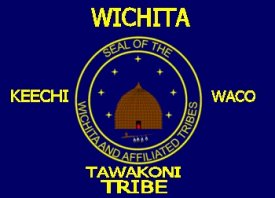 http://www.texasindians.com/waco.htm |
Prior to the founding of the town, the region of the present day city was inhabited until about 1830 by a Wichita Native American group known as the
"Waco" or "Hueco", an indian-tribe that was almost completely annihilated in that year by a tribe of Cherokee. The Waco people, for whom the city is named, lived at the strategic crossing of the Brazos when Texas Rangers established Fort Fisher there in 1837. Neil McLennan settled in an area near the South Bosque River in 1838. Jacob De Cordova bought McLennan's property and hired George B. Erath, a former Texas Ranger and surveyor to inspect the area. In 1849, Erath designed the first block of the city. Property owners wanted to name the city Lamartine, but Erath convinced them to name the area Waco Village, in honor of the Native Americans who had lived there. Shapley Ross built the first house in Waco, a double-log cabin, on a bluff overlooking the springs in March 1849. His daughter Kate was the first white child to be born in Waco. |
Waco, covering a land area of around 76 square miles, with a mean elevation of 400 feet, was incorporated in 1857. Beginning in the late 1860s, Waco benefited from its location on the Chisholm Trail. A cattle route between San Antonio Texas and Abilene Kansas. |
 http://www.thechisholmtrail.com/ |
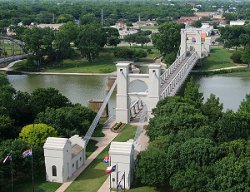 http://www.thecitiesof.com/texas/waco/waco-suspension-bridge.jpg |
In 1866, Waco's leading citizens embarked on an ambitious project to build the first bridge to span the wide Brazos River. They formed the Waco Bridge Company to build the 475-foot brick Waco Suspension Bridge, which was called the longest span of any bridge west of the Mississippi River when completed in 1870. The economic effects of the Waco bridge were immediate and large, attracting cattle runs from the nearby Chisholm Trail and increasing the population of the city, as immigrants now had a safe passage for their horse drawn carriages to cross the river. Since 1971, the bridge has been open only to pedestrian traffic and is in the National Register of Historic Places. |

| In the 1890s, William Cowper Brann published the highly successful Iconoclast newspaper in Waco. One of his targets was Baylor University. Brann revealed that Baylor officials had been importing South American children recruited by missionaries and making house-servants out of them. Brann was shot in the back by Tom Davis, a Baylor supporter. Brann then wheeled, drew his pistol, and killed Davis. Brann was helped home by his friends, and died there of his wounds. |
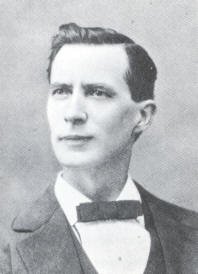 http://en.wikipedia.org/wiki/William_Cowper_Brann |
 http://www.wacocottonpalace.org/ |
In 1894, the first Cotton Palace fair and exhibition center was built to reflect the dominant contribution of the agricultural cotton industry in the region. Since the end of the Civil War, cotton had been cultivated in the Brazos and Bosque valleys, and Waco had become known nationwide as a top producer. Over the next 23 years, the annual exposition would welcome over eight million attendees. The opulent building which housed the month-long exhibition was destroyed by fire and rebuilt in 1910. In 1931, the exposition fell prey to the Great Depression, and the building was torn down. However, the annual Cotton Palace Pageant continues, hosted in late April in conjunction with the Brazos River Festival. |
| In 1916, a mentally challenged African American teenager named Jesse Washington was tortured, mutilated and burned to death in the town square by a mob that seized him from the McLennan County Courthouse, where he had been convicted of murdering a white woman. 15,000 spectators, mostly citizens of Waco, were present. The commonly-named Waco Horror drew international condemnation and became the cause célèbre of the nascent National Association for the Advancement of Colored People's anti-lynching campaign. In 2006, the Waco City Council officially condemned the lynching, which took place without opposition from local political or judicial leaders |
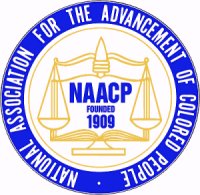 http://www.naacp.org/ |
 http://www.10thcoa.courts.state.tx.us/ |
In 1923, the Texas Legislature created the Tenth Civil Court of Appeals and placed it in Waco; it is now known as the 10th Court of Appeals. The Tenth Court of Appeals hears approximately 400 criminal and civil appeals a year from lower courts in eighteen counties of Texas. Bosque, Brazos, Burleson, Coryell, Ellis, Falls, Freestone, Hamilton, Hill, Johnson, Leon, Limestone, Madison, McLennan, Navarro, Robertson, Somervell, and Walker Counties. The Court is composed of a Chief Justice and two Justices. |
|

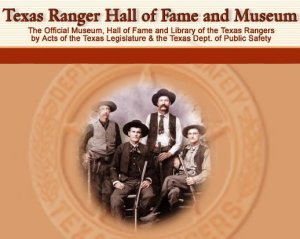 http://www.texasranger.org/ |
The Texas Rangers have a heritage that began with the earliest settlements in Texas. They are part of the history of the Old West, and part of its mythology. The term "Texas Ranger" did not appear officially in a piece of legislation until 1874. The official records show that they were called by many names: ranging companies, mounted gunmen, mounted volunteers, minutemen, spies, scouts and mounted rifle companies. A Ranger is an officer who is able to handle any given situation without definite instructions from his commanding officer, or higher authority. This ability must be proven before a man becomes a Ranger. In 1976 it was further designated the official Hall of Fame for the Rangers and renamed the Texas Ranger Hall of Fame and Museum. Renovations by the Waco government earned this building green status, the first Waco government-led project of its nature. |
| In 1978, bones were discovered emerging from the mud at the confluence of the Brazos River and the Bosque River. Subsequent excavations revealed that the bones were 68,000 years old and belonged to a species of mammoth. Eventually, the remains of at least 24 mammoths, one camel, and one large cat were found at the site, making it one of the largest findings of its kind. Scholars have puzzled over why such a large herd had been killed all at once. The site is currently being looked at by the National Park Service for possible inclusion into the National Park system. They are conducting a special resource study to be presented to Congress. | 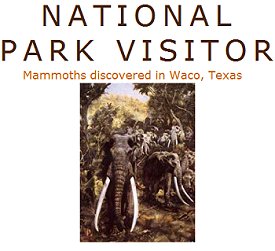 http://www.nationalparkvisitor.com/2009/12/mammoths-discovered-in-waco-texas.html |
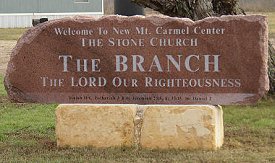 http://en.wikipedia.org/wiki/Branch_Davidian | On February 28, 1993 there was a shoot out in which six Davidians and four agents of the United States Bureau of Alcohol, Tobacco and Firearms died. After 51 days on April 19, 1993 a standoff between FBI agents and Branch Davidians ended in a fire that destroyed their compound located in Mt. Carmel, near Waco. Seventy-four people, including leader David Koresh, died in the blaze. |
|
Join The Cities Of . Com |
Today's Good News |
